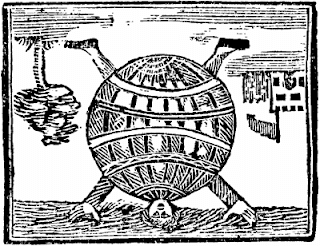The World Turned Upside Down: The Uselessness of Conventional Economic Wisdom
There is a story, possibly true,
that when the British surrendered to American and French forces at Yorktown,
effectively ending British rule of America, someone in the British army sang or
played an old English folk song, “The World Turned Upside Down.” (See https://en.wikipedia.org/wiki/The_World_Turned_Upside_Down)
I think I know how the British felt. Many of the assumptions economists have made about
economic reality and economic policies now seem out-of-date or even reversed.
UNITED STATES
The Fed fought inflation; now it
sets inflation targets when there is no inflation.
The Fed worries about deflation even
though the major source is a fall in energy and commodity prices. Another source is the fall in the prices of technology products.
There is a large increase in the money supply, large government deficits, a large trade deficit, and a large decrease in the unemployment rate. Economic theory and past experience says that there should be an increasing inflation rate. There isn't.
There is a large increase in the money supply, large government deficits, a large trade deficit, and a large decrease in the unemployment rate. Economic theory and past experience says that there should be an increasing inflation rate. There isn't.
America is experiencing a long
period of real economic growth without inflation. Unemployment is as low as realistically
possible. Rather than rejoicing,
economic, business and political commentators seem to believe there is
something fundamentally wrong with this.
Since the end of World War II, a key
part of American foreign policy has been the expansion of free trade. Now presidential candidates of both parties,
and over half the American people, want to reverse free trade. Economic nationalism is rising at the same
time as large American corporations are about to receive over half their sales
and profits from overseas operations.
America worried about importing too
much oil; now America is worried about producing too much oil.
Interest rates are important because
they are the price of capital, which determines how capital is allocated. Now interest rates are a policy tool of the
Fed. They are artificially low with no
thought about how they are affecting capital allocation.
The stock market was a place where
companies went to raise new capital.
Now, through massive share buybacks, it is a place where companies
reduce equity capital.
It has been government policy that
annual budget deficits are manageable as long as the national debt-to-nominal
GDP ratio was low. That is, as long as
the national debt rose at a lower rate than nominal GDP. But since 2008, the national debt has risen
much faster than nominal GDP. We are
experiencing historically high and rising peacetime national debt-to-GDP ratios. So far, there has been little consequence
because of historically low interest rates.
If nominal interest rates rise, there will be larger budget deficits.
Seven years into a recovery interest
rates and inflation rates should be rising.
No one could conceive that central banks in the U.S., Europe, Japan and
other countries would set zero short-term interest rates this far into the
recovery.
Negative interest rates, both real
and nominal, were considered possible but not realistic. Most industrialized countries have had some
negative interest rates.
The Fed stopped looking at the
increase in the money supply as a policy tool about 30 years ago. Now a huge increase in the money supply is
being used to finance a huge increase in the national debt.
Tax cuts and a larger deficit are traditional tools to fight a recession. They are being advocated as sound fiscal policy at the top of a business cycle.
Tax cuts and a larger deficit are traditional tools to fight a recession. They are being advocated as sound fiscal policy at the top of a business cycle.
An economy can be in recession if
private spending is too low (inadequate private aggregate demand). This implies private saving is too high. The solution is that government spending
should be increased and/or taxes lowered.
The result is a larger government deficit, which is financed by private
saving. But with structural deficits at the
national and state levels, private saving now has to be high to finance
government deficits. Also, the United States has to continue to take in a high percent of cross-border financial flows.
CHINA
By some measures, using purchasing
price parity (PPP) measurement, the Chinese economy is as big or possibly
larger than the American economy.
(Although many analysts believe the past growth rates and the real
economy of China are overstated.)
China has over half of the world’s
high-speed railroad trackage and intends to increase it by two-thirds over the
next 10 years. By 2025, China intends to
have every city in China with a population of at least a half a million to be
connected to the high-speed rail network.
The point? China spends substantially
more on infrastructure than the United States does, and China uses more
advanced technology.
The U.S. high-speed rail
mileage? Zero. Japan has offered to give the U.S. its
high-speed rail technology. I think
that’s called foreign aid.
China is planning a high-speed
railroad that will take passengers and freight from Beijing to Moscow in 33
hours and London in 48 hours. Some
sections of the railroad have already been built. The geopolitical idea is to bypass American
control of the world’s shipping lanes.
China has four times as many
skyscrapers as the United States.
China has most of the long and high bridges in the world.
China has most of the long and high bridges in the world.
China has more cars than the United
States. China has more smartphones.
China produces most of the world's solar panels. On the other hand, China emits more carbon into the atmosphere than any other country.
China produces most of the world's solar panels. On the other hand, China emits more carbon into the atmosphere than any other country.
GLOBAL
Recessions were caused by rising
global commodity prices. Now there is a
fear that a global recession could be caused by falling commodity prices and
their longer-term consequences.
In the post-WWII period, there had
never been a global recession. Until
2007-2009.
At Japan's current rate of economic growth, their economy will double in size in 100 years. But by then there will be very few, if any, Japanese.
Almost all countries are experiencing rapidly rising national debt-to-nominal GDP ratios. Economic history indicates bad things start to happen if the ratio goes over 90%. Many countries, including the U.S., are over 100%. Japan has the highest ratio at 230%, a ratio no one thought could be possible without catastrophic economic consequences. But this high and rising ratio is made possible because Japanese families are apparently willing to lend their government unlimited funds at zero interest.
At Japan's current rate of economic growth, their economy will double in size in 100 years. But by then there will be very few, if any, Japanese.
Almost all countries are experiencing rapidly rising national debt-to-nominal GDP ratios. Economic history indicates bad things start to happen if the ratio goes over 90%. Many countries, including the U.S., are over 100%. Japan has the highest ratio at 230%, a ratio no one thought could be possible without catastrophic economic consequences. But this high and rising ratio is made possible because Japanese families are apparently willing to lend their government unlimited funds at zero interest.
For decades we have been told that
we are running out of oil. Now we are
told there is too much oil. Proven reserves
have been greatly increased and because of improving drilling technology oil
can be extracted at lower and lower marginal and average cost.
For four decades, Americans have
been told that nuclear energy is bad and dangerous. Now the world is planning on building
hundreds of nuclear power plants using new technology. This is a major strategy to reduce global
warming. But not in the United States.
Electric engines in cars will reduce carbon emissions and slow global warming. Unless the electricity is generated by burning coal or other fossil fuels.
Electric engines in cars will reduce carbon emissions and slow global warming. Unless the electricity is generated by burning coal or other fossil fuels.
The world faced a Malthusian future
of exponential population growth caused by high birth rates, not enough food, and
the depletion of energy and natural resources.
Since then, most of the world has birth rates below replacement and the
rest of the world has falling birth rates. Industrial countries worry about
future declining populations and labor forces.
Food production has undergone a series of technological revolutions that
has greatly increased the quantity, if not the quality, of food. Energy resources are almost unlimited with
even more technological revolutions on the horizon.
Since the 1950s, Americans have been
hearing how other forms of political economy would overcome the U.S. First Russia, then Germany, then Japan, then
the Four Dragons of Asia. Behind all these predictions was the description
of the advantages of socialism or state capitalism over our relatively autonomous
capitalism. Commentators suggested we
adopt some of the government planning policies of these countries. We didn’t. These countries and their economic systems
turned out not to be a threat to us but they are a warning to China.
MORE CONVENTIONAL WISDOM
Red wine, dark chocolate, and beer were bad for your health. Now they are health foods. This is my idea of progress!
Red wine, dark chocolate, and beer were bad for your health. Now they are health foods. This is my idea of progress!










Comments
Post a Comment